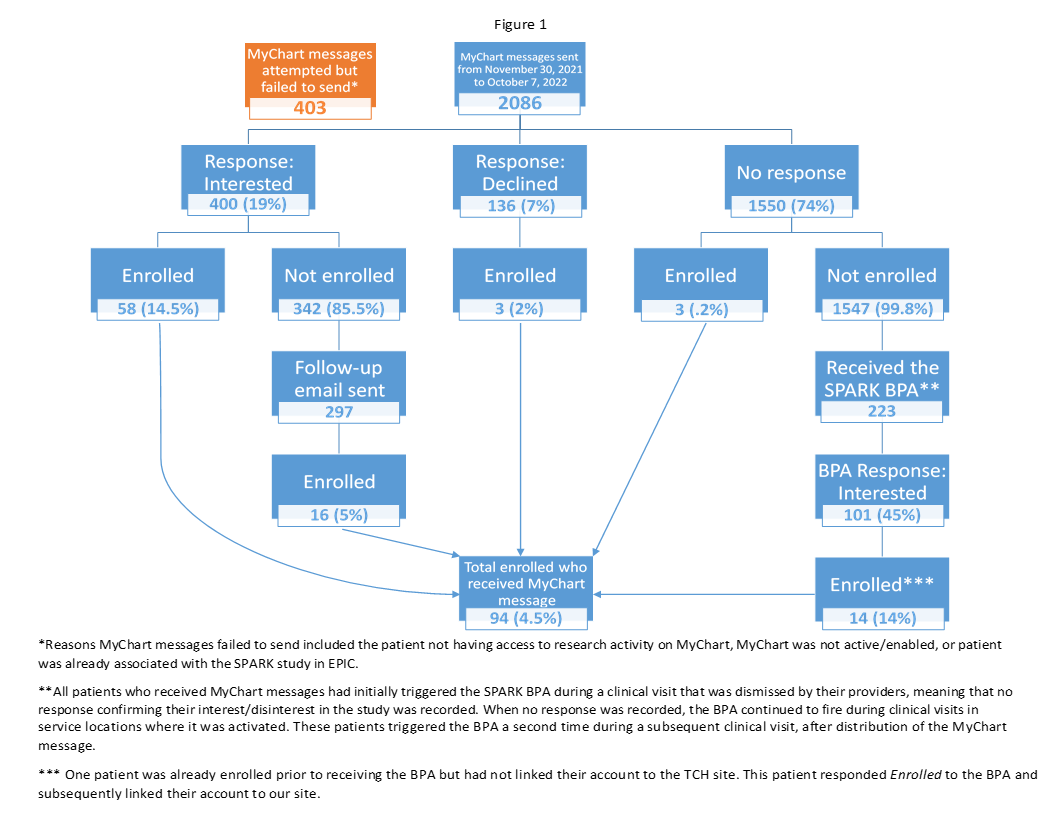Hospital Medicine: Systems/Population-based Research
Hospital Medicine 4
511 - Utility of MyChart for Recruitment Into a U.S.-based Autism Research Cohort
Saturday, April 29, 2023
3:30 PM - 6:00 PM ET
Poster Number: 511
Publication Number: 511.221
Publication Number: 511.221
Robin P. Kochel, Baylor College of Medicine, Houston, TX, United States; Ivana Lozano, Baylor College of Medicine, Pearland, TX, United States; Gabriela Marzano, Baylor College of Medicine, Houston, TX, United States; Rebecca J. Sanchez, Baylor College of Medicine, Houston, TX, United States; My-Linh Luu, Baylor College of Medicine, Houston, TX, United States; Leandra N. Berry, Baylor College of Medicine, Houston, TX, United States

Robin P. Kochel, PhD (she/her/hers)
Associate Professor
Baylor College of Medicine
Houston, Texas, United States
Presenting Author(s)
Background: We previously demonstrated that a research Best Practice Advisory (BPA) can successfully engage providers in the recruitment of autism patients for the national SPARK study (SPARK; Simon et al., 2022; Duhon et al., 2022). However, provider dismissal of the BPA is common and tends to increase over time as a function of alert fatigue. Therefore, many families may not learn about SPARK via their provider. MyChart is a secure web-portal that allows patients to actively manage their healthcare, including to-and-fro messaging with providers and staff. As such, MyChart may effectively outreach about SPARK to families whose providers dismissed the BPA.
Objective: To examine the utility of MyChart in recruiting pediatric patients with autism for the SPARK study at the Texas Children’s Hospital site.
Design/Methods: Between 11/2021 and 10/2022, 2,086 families of children with ASD who triggered the SPARK BPA but had no provider response were sent a SPARK recruitment message via MyChart. Families could respond as either Interested or Declined; if Interested, the research team emailed them additional study information with the registration link. 297 Interested families who had not enrolled after ~3 months were sent a reminder email. 223 families who never responded to the MyChart message triggered the SPARK BPA a second time during a subsequent clinical visit. Participant responses and SPARK enrollment status were tracked by research staff and analyzed descriptively.
Results: 400 (19%) families responded Interested to the MyChart message; 58 (14.5%) of this group enrolled after receiving the initial recruitment email and 16 (5%) enrolled after the reminder email. 136 (7%) families responded Declined to the MyChart message; 3 (2%) of them enrolled. 1550 (74%) did not respond to the MyChart message; 3 (0.2%) enrolled. Of the 223 who triggered the BPA again, 14 (14%) enrolled. Overall, 94 (4.5%) of families who received a MyChart message enrolled (see Figure 1). Analyses examining rates of study completion and factors that predict enrollment following receipt of the MyChart message are currently underway.
Conclusion(s): One in five families indicated interest in the SPARK study after receiving the MyChart message, and ~20% of this group enrolled after receiving emailed information. Although these numbers are lower than those with the SPARK BPA, they still demonstrate the viability of MyChart to engage families in the study. Further research should explore functionality within the electronic health record to support clinical-research recruitment and retention efforts.

